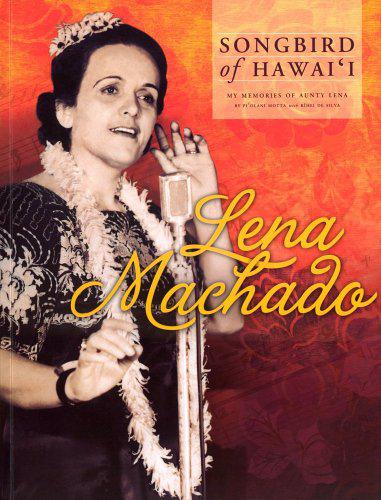Digital Collections
Celebrating the breadth and depth of Hawaiian knowledge. Amplifying Pacific voices of resiliency and hope. Recording the wisdom of past and present to help shape our future.
Lena Machado is, without question, Hawai‘i’s finest female singer-composer of the last century, maybe of all time. Today, years after her passing, our Songbird is still revered, still imitated, and still unrivaled.
Aunty Lena herself never claimed to be famous. She never pushed her way to the front or tried to outdo others with her talent. Because she believed in ha‘aha‘a—in humility—she chose, instead, to let her work speak for itself.
This book serves exactly that purpose. It compiles, for the first time ever, a significant body of her work—thirty songs, thirty music sheets, thirty stories, and more than 60 photographs—all of which speak eloquently of Aunty Lena’s extraordinary talent and character.
This book holds surprises for even the most knowledgeable of Machado’s fans. But it is equally accessible to those who know little or nothing of the girl whose storied career began when she was discovered singing in the branches of a downtown Honolulu mango tree.
This book sets the record straight on such seemingly familiar songs as "Pōhai Ke Aloha," "Pua Māmane," and the incorrectly titled "Ma ‘ane‘i Mai ‘Oe." It also introduces us to ten of Aunty Lena’s unknown and previously unpublished mele, several of which will be compared favorably, in quality of poetry and music, to the very best of Aunty Lena’s work.
When Pi‘olani Motta, the hānai daughter and life companion of Lena Machado, first began to assemble this book, her intentions were modest. "I wanted to share some of the songs that Aunty Lena left me and the memories that go with them."
After two decades of work and with the help of Kamehameha Schools and Ka‘iwakīloumoku, Motta has more than surpassed her early expectations.
Lena Machado, Hawai‘i’s Songbird delights and informs, captivates and instructs. It is a songbook with short stories, a reference book with romantic interludes, and a biography with literary analysis. It can be read from cover to cover—or one piece at a time. It belongs in the classroom, in the library reference room, and on the family piano. Above all, it gives new validation to the old Hawaiian saying, "Ua lehulehu a manomano ka ‘ikena a ka Hawaiʻi." Great and numerous is the knowledge of the Hawaiian people. It celebrates the genius of Lena Kaulumau Wai‘ale‘ale Machado.
We have excerpted five songs from this newly published collection. Please click on the links below to view the text, translation, and mo‘olelo for each of these mele. Photos and music sheets are not included here; they are, however, available in the book itself.
Aloha Nō
Aunty Lena and Uncle Lu—Lena Wai‘ale‘ale and Luciano K. Machado—were introduced to each other at a parade in Honolulu in 1923. They were both celebrities. Aunty Lena was being honored as an up-and-coming singer, and she rode in an open car. Uncle Lu was a detective with the Honolulu Police Department and had just been named the city and county’s "Most Popular Employee of the Year."
Ho‘onanea
Aunty Lena was always very attentive; she was an excellent listener. She said that when she sold lei as a girl in Honolulu, she would listen to the stories of the women she worked with as they sat around stringing flowers and passing the time.
Ku‘u Wā Li‘ili‘i
Aunty Lena enjoyed telling us the story of the event that inspired "Ku‘u Wā Li‘ili‘i"—about how, on the sixteenth birthday, she tried to be a lady but couldn’t live up to her own expectations.
Lei Kiele
"Lei Kiele" is like "Pua Māmane" and "Ho‘ohaehae" because most people don’t know that Aunty Lena composed it. They think it’s an old song whose author’s name was forgotten long ago. In fact, it’s not that old. Aunty Lena copyrighted "Lei Kiele" in 1935, so it’s probably a newer song that some of her well-known favorites like "Ho‘onanea," "Kauoha Mai," and "Kamalani O Keaukaha." But people still find it hard to believe.
Pua Māmane
Aunty Lena was the youngest of the five children of Robert and Louise Poepoe Wai‘ale‘ale. The five, from hiapo to muli loa, were William, Gussie, Ivy, Robert Jr., and Lena. Aunt Lena was raised in Honolulu by her hānai parents and didn’t know too much about her siblings. But as she got older, she got more inquisitive. She said she was in her teens when she first met them.
Finally, as a behind-the-scenes treat, we have excerpted two selections from the more than ten hours of interview transcripts on which the mo‘olelo of the book are based. Please click on the link below to view Pi‘olani Motta’s own words as she talks story first about life with Aunty Lena and then about the "lōlō" circumstances behind the composition of "Ku‘u Wā Li‘ili‘i." The second of these includes a sound clip of the actual session.
Talking Story with Aunty Pi‘olani Motta
And so Aunty Lena got to see our lifestyle, our family, and she thought my mother was maybe a little burdened down with you know, children. So she said, "I’ll take your oldest, and we can give you some relaxation with the other children."
. . . They had high heel shoes and they had stockings and they had gloves, and they had pushed up corsets and all this hairdo like the Gibson girls, and she wanted a hat and long gloves.
